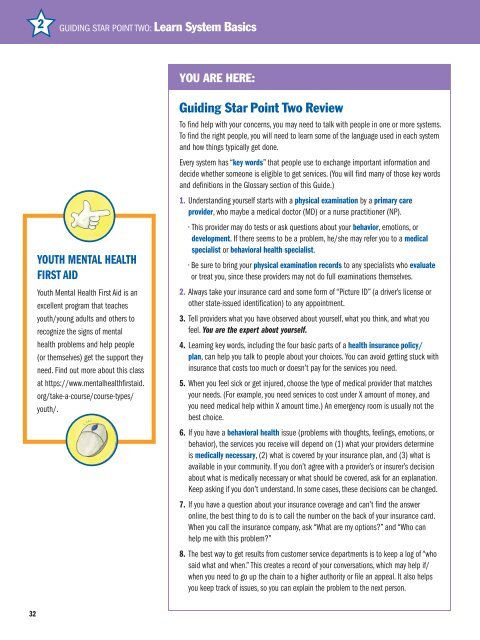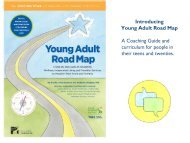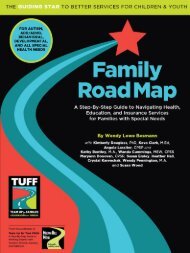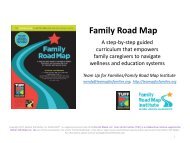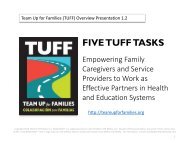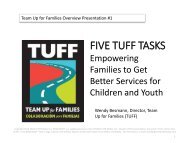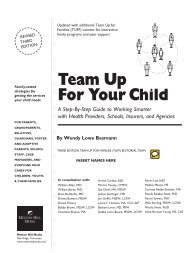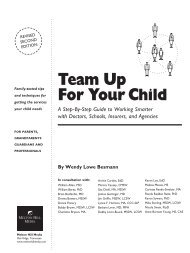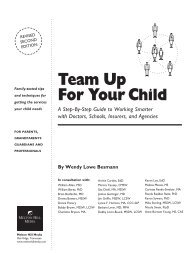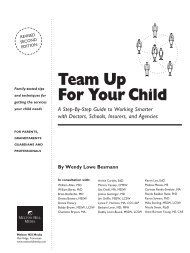Look Inside Young Adult Road Map
You also want an ePaper? Increase the reach of your titles
YUMPU automatically turns print PDFs into web optimized ePapers that Google loves.
2<br />
Guiding Star Point Two: Learn System Basics<br />
You are here:<br />
Youth Mental health<br />
First Aid<br />
Youth Mental Health First Aid is an<br />
excellent program that teaches<br />
youth/young adults and others to<br />
recognize the signs of mental<br />
health problems and help people<br />
(or themselves) get the support they<br />
need. Find out more about this class<br />
at https://www.mentalhealthfirstaid.<br />
org/take-a-course/course-types/<br />
youth/.<br />
Guiding Star Point Two Review<br />
To find help with your concerns, you may need to talk with people in one or more systems.<br />
To find the right people, you will need to learn some of the language used in each system<br />
and how things typically get done.<br />
Every system has “key words” that people use to exchange important information and<br />
decide whether someone is eligible to get services. (You will find many of those key words<br />
and definitions in the Glossary section of this Guide.)<br />
1. Understanding yourself starts with a physical examination by a primary care<br />
provider, who maybe a medical doctor (MD) or a nurse practitioner (NP).<br />
• This provider may do tests or ask questions about your behavior, emotions, or<br />
development. If there seems to be a problem, he/she may refer you to a medical<br />
specialist or behavioral health specialist.<br />
• Be sure to bring your physical examination records to any specialists who evaluate<br />
or treat you, since these providers may not do full examinations themselves.<br />
2. Always take your insurance card and some form of “Picture ID” (a driver’s license or<br />
other state-issued identification) to any appointment.<br />
3. Tell providers what you have observed about yourself, what you think, and what you<br />
feel. You are the expert about yourself.<br />
4. Learning key words, including the four basic parts of a health insurance policy/<br />
plan, can help you talk to people about your choices. You can avoid getting stuck with<br />
insurance that costs too much or doesn’t pay for the services you need.<br />
5. When you feel sick or get injured, choose the type of medical provider that matches<br />
your needs. (For example, you need services to cost under X amount of money, and<br />
you need medical help within X amount time.) An emergency room is usually not the<br />
best choice.<br />
6. If you have a behavioral health issue (problems with thoughts, feelings, emotions, or<br />
behavior), the services you receive will depend on (1) what your providers determine<br />
is medically necessary, (2) what is covered by your insurance plan, and (3) what is<br />
available in your community. If you don’t agree with a provider’s or insurer’s decision<br />
about what is medically necessary or what should be covered, ask for an explanation.<br />
Keep asking if you don’t understand. In some cases, these decisions can be changed.<br />
7. If you have a question about your insurance coverage and can’t find the answer<br />
online, the best thing to do is to call the number on the back of your insurance card.<br />
When you call the insurance company, ask “What are my options?” and “Who can<br />
help me with this problem?”<br />
8. The best way to get results from customer service departments is to keep a log of “who<br />
said what and when.” This creates a record of your conversations, which may help if/<br />
when you need to go up the chain to a higher authority or file an appeal. It also helps<br />
you keep track of issues, so you can explain the problem to the next person.<br />
32


